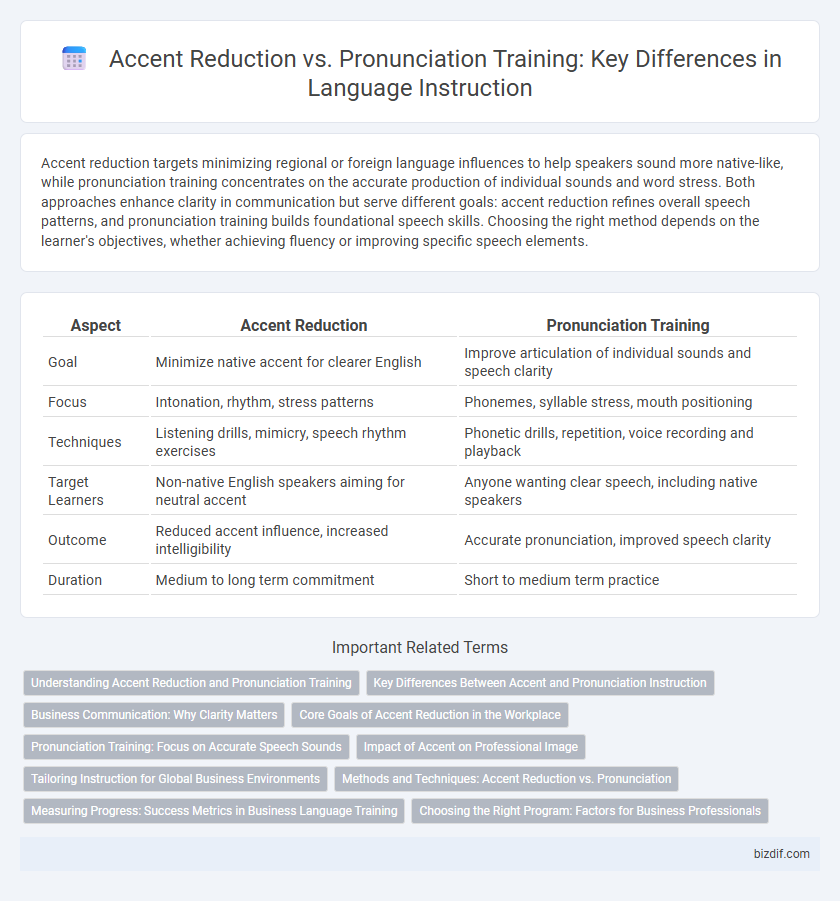Accent reduction targets minimizing regional or foreign language influences to help speakers sound more native-like, while pronunciation training concentrates on the accurate production of individual sounds and word stress. Both approaches enhance clarity in communication but serve different goals: accent reduction refines overall speech patterns, and pronunciation training builds foundational speech skills. Choosing the right method depends on the learner's objectives, whether achieving fluency or improving specific speech elements.
Table of Comparison
| Aspect | Accent Reduction | Pronunciation Training |
|---|---|---|
| Goal | Minimize native accent for clearer English | Improve articulation of individual sounds and speech clarity |
| Focus | Intonation, rhythm, stress patterns | Phonemes, syllable stress, mouth positioning |
| Techniques | Listening drills, mimicry, speech rhythm exercises | Phonetic drills, repetition, voice recording and playback |
| Target Learners | Non-native English speakers aiming for neutral accent | Anyone wanting clear speech, including native speakers |
| Outcome | Reduced accent influence, increased intelligibility | Accurate pronunciation, improved speech clarity |
| Duration | Medium to long term commitment | Short to medium term practice |
Understanding Accent Reduction and Pronunciation Training
Accent reduction targets modifying specific speech patterns to minimize regional or foreign accents, improving clarity and listener comprehension. Pronunciation training emphasizes correct phonetic production of individual sounds and word stress to achieve accurate speech. Both approaches enhance verbal communication, but accent reduction focuses more on overall speech naturalness, while pronunciation training deals with precise sound articulation.
Key Differences Between Accent and Pronunciation Instruction
Accent reduction targets reducing regional or foreign speech patterns to improve intelligibility, while pronunciation training focuses on teaching the correct sounds and rhythm of a language. Accent instruction often includes cultural nuances and intonation, whereas pronunciation training emphasizes phonetic accuracy and articulation. Both approaches aim to enhance communication but differ in scope, with accent reduction addressing broader speech habits and pronunciation training honing specific phonological skills.
Business Communication: Why Clarity Matters
Accent reduction targets minimizing regional or non-native speech patterns to enhance understandability, while pronunciation training focuses on mastering specific sounds and intonation within a language. In business communication, clarity drives effective message delivery, reducing misunderstandings in multinational environments. Prioritizing both ensures professionals convey ideas confidently, fostering stronger partnerships and smoother negotiations.
Core Goals of Accent Reduction in the Workplace
Accent reduction in the workplace aims to enhance clear communication by minimizing strong regional or foreign accents, thereby improving mutual understanding among employees and clients. Key goals include increasing speech clarity, promoting professional confidence, and facilitating smoother workplace interactions. Effective accent reduction supports better collaboration, reduces misunderstandings, and contributes to a more inclusive work environment.
Pronunciation Training: Focus on Accurate Speech Sounds
Pronunciation training emphasizes mastering accurate speech sounds by targeting phonetic details such as vowel length, consonant articulation, and intonation patterns. This approach improves clarity and intelligibility, enabling learners to produce sounds that closely match native speakers. Effective pronunciation training uses auditory discrimination exercises and repetitive practice to internalize precise sound production.
Impact of Accent on Professional Image
Accent reduction and pronunciation training both enhance clarity, but accent reduction specifically targets modifying speech patterns to align with standard professional norms, significantly impacting perceived credibility and professionalism. A polished accent reduces potential misunderstandings and fosters stronger client and colleague trust, directly influencing career advancement opportunities. Employers often associate neutral or widely understood accents with competence, making accent reduction a strategic investment in professional image.
Tailoring Instruction for Global Business Environments
Accent reduction targets minimizing regional or native language influences to enhance clarity, while pronunciation training emphasizes accurate articulation of sounds and intonation for effective communication. Tailoring instruction for global business environments involves integrating cultural nuances and industry-specific vocabulary to ensure learners can engage confidently across diverse professional contexts. Customized programs improve comprehension and foster stronger international partnerships by aligning linguistic skills with organizational goals.
Methods and Techniques: Accent Reduction vs. Pronunciation
Accent reduction techniques emphasize modifying speech patterns through targeted phonetic exercises, intonation adjustment, and rhythm training to minimize regional or native-language influences. Pronunciation training focuses on the accurate articulation of individual sounds, stress patterns, and syllable emphasis using phoneme drills and listening repetition. Both methods employ auditory feedback and visual aids, but accent reduction integrates cultural and linguistic nuances while pronunciation training targets fundamental sound production.
Measuring Progress: Success Metrics in Business Language Training
Measuring progress in accent reduction relies on quantifiable metrics such as phonetic accuracy, reduction in native language interference, and listener comprehensibility scores. Pronunciation training success is often evaluated through speech clarity assessments, vowel and consonant articulation precision, and fluency benchmarks. In business language training, utilizing standardized evaluation tools like the International Phonetic Alphabet (IPA) and real-time speech analytics platforms ensures objective tracking of learners' improvements.
Choosing the Right Program: Factors for Business Professionals
Choosing the right program for accent reduction versus pronunciation training involves evaluating the specific needs of business professionals, such as clarity of communication and industry jargon adaptation. Effective programs prioritize phonetic accuracy, intonation, and rhythm to enhance comprehension in a professional setting. Business professionals should consider courses offering personalized feedback, flexible scheduling, and proven outcomes in reducing misunderstanding during high-stakes meetings or presentations.
Accent reduction vs pronunciation training Infographic

 bizdif.com
bizdif.com